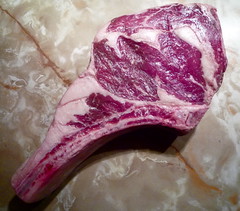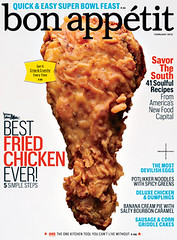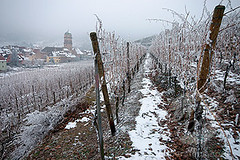 fig. a: taking a vow
fig. a: taking a vow
While others were still trying to get over their New Year's Eve hangovers, I spent New Year's Day trying to get over my New Year's Eve hangover and taking a solemn vow.
It went something like this:
My Beautiful Dry-Aged Steak
I make this vow to you.
I will do almost nothing to you. I will not get fancy. You are not the canvas for my ideas about how Cambodian and Croatian cuisines relate to one another. You, like very few ingredients in the world--gray pearls of beluga caviar, Domaine de la Romanée-Conti, Oreos--do not need my help to be delicious. I will do everything in my power to avoid fucking you up. I will not get in the way of your magnificence. I shall season you well. I will brown you deeply. I will cook you rare, and let you rest as long as you need. When I slice you, I will slice against your grain, and season you again. I will adorn you only in pan drippings, and perhaps a simple compound butter. I will consume all that you are, and leave nothing uneaten.
"My Beautiful Dry-Aged Steak" appeared in Issue #2 of
Lucky Peach, of course, and it followed up "another transmission from Harold McGee's Orbital Desk in Outré Space" about enzymes and their role in the dry-aging process. As McGee explains, by harnessing the powers of enzymes, "we can get our food to make
itself more delicious," which is why he refers to them as "nanocooks--the true molecular cooks." Examples of this enzymatic process in action? Ripening, fermentation, and, yes, dry-aging.
For those who haven't had the pleasure of experiencing the joy of dry-aging, it involves keeping parts of the carcass in a carefully controlled environment (one with cool temperatures, and fairly high humidity) for a period of several weeks. Doing so allows enzymes to work their magic--"[breaking] down the meat's proteins, fats, and glycogen... into amino acids [including glutamate], fatty acids, and sugars," as well as causing the meat to lose some of its moisture (hence the name) and thereby concentrating its flavours--and the result is beef that has an extraordinary complexity and depth to it.
Sounds great, right? It is. Astounding, actually. The problem is, dry-aging is a costly, time-consuming process, one that doesn't jibe with the economic logic of our supermarket culture. Consequently, it's hard to find dry-aged beef. It's also a process that's hard to duplicate at home because of the smells and flavours that occupy your basic household refrigerator, but also because your basic household refrigerator isn't particularly well temperature-controlled (think of how many times per day your refrigerator door gets opened and closed). As McGee puts it: "Dry-aging is very difficult to do well at home."
What's the answer? Get more butchers to take their beef more seriously.
Start by frequenting a local butcher shop. Ask if their beef is dry-aged. If it is, great--consider yourself lucky. If it isn't, ask them to consider doing so. Then, while you're at it, ask them where their beef comes from. Are they able to give you a straight answer? If not, move on to another butcher, one who's more willing to make an effort, or just keep asking. The more people ask, the greater the likelihood that things might improve.*
As it turns out, we'd just paid another pilgrimage to our friends at
Fleisher's. Not only do they dry-age their steaks at Fleisher's, but their beef is local, grass-fed, organic,
and sustainably raised. The combination is pretty much impossible to beat.
 fig. b: our beautiful dry-aged steak
fig. b: our beautiful dry-aged steak
Our beautiful dry-aged steak was pricey (understandably), but it was one-and-a-half inches thick, and it wasn't just beautiful, it was gorgeous. It was also a hell of a lot cheaper than a comparable steak from a reputable steak house.
We took the vow seriously. We kept things very simple and we didn't fuck it up. Just the steak, the
jus, some sautéed mushrooms, a Caesar salad, and a killer bottle of wine. We browned the steak deeply, finished it in the oven, and gave it plenty of time to rest.** We did those enzymes proud. It was a glorious affair.
Taking a vow,
committing to dry-aged beef may sound silly, but it's actually a pretty great idea. It'll probably mean that you eat a lot less beef, but it'll definitely mean that you enjoy it a lot more when you do.***
aj
* In Montreal, things are a little difficult when it comes to sourcing high-quality beef, a fact made all too clear in the pages of
The Art of Living According to Joe Beef. There are a few establishments that dry-age their meat (Boucherie de Tours and Queue de Cheval come to mind), but locating beef that's dry-aged, locally and sustainably raised, grass-fed, and organic is another matter. Customers need to be more demanding. Restaurants need to be more demanding.
** Not sure how to prepare your beautiful dry-aged steak? We've been following the Fleisher's Method for the last couple of years. You can find directions
here. Given the size and thickness of the steak, our oven time was about 14 minutes.
*** Those familiar with the work of Michael Pollan will recognize this basic argument. Pollan has argued time and time again that we, as a culture (North American culture), should be eating a lot less meat, but he's not vegetarian.
This is the way he responded to the vegetarian question in an interview with
Democracy Now!:
SHARIF ABDEL KOUDDOUS: Are you vegetarian?
MICHAEL POLLAN: No, I’m not. I eat meat. I eat much less meat than I used to. And I don’t think the answer is necessarily, you know, giving up meat. There are kinds of meat that have much less of a carbon footprint. I mean, we’ve been describing grain-fed beef. But what if you feed cattle on grass? When you feed cattle on grass, they’re not competing with humans for food, because we can’t digest grass. They’re geniuses; they can digest grass, because they have a rumen. And that — and well run, rotationally grazed cattle, on grass, actually build carbon in the soil. They can be used to sequester carbon. So there is a way to organize meat production that would reduce its carbon footprint dramatically. Now, it must be said, that meat is much more expensive and harder to find, with the result that I eat very little of it. But that’s the kind of meat I eat.
What he leaves out here, but discusses elsewhere, is the all-important taste factor.
 fig. a: my kind of UFC
fig. a: my kind of UFC fig. b: Bon-Ton Mini Mart
fig. b: Bon-Ton Mini Mart fig. c: Bon-Ton's UFC
fig. c: Bon-Ton's UFC










